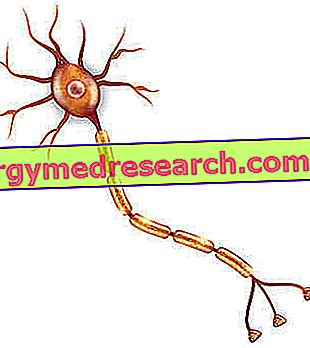Generality
The nerves are important structures of the peripheral nervous system, which result from the grouping of several axons and which have the important task of transporting nerve impulses from the central nervous system to the periphery, and vice versa.

Cranial nerves originate in the brain and innervate the head and neck; the spinal nerves, on the other hand, originate in the spinal cord and innervate all parts of the body not innervated by the cranial nerves.
Depending on the type of axons that constitute them, the nerves can cover three functions: a motor function, a sensory function and a mixed function. Nerves with motor function transmit nerve impulses from the central nervous system to skeletal muscles and glands; the nerves with sensory function lead the nerve impulses from the peripheral anatomical districts (eg: cutaneous receptors) to the central nervous system; finally, the nerves with mixed function have the double ability to act both as nerves with motor function and as nerves with a sensory function.
Short review of what a neuron is
Neurons are the cells that form the entire nervous system . Neurologists often define them as " functional units of the nervous system ".
The task of the neurons is to generate, exchange and transmit all those signals of a nervous nature that allow muscle movement, sensory perceptions, reflex responses and so on.
Typically, one neuron consists of three parts:
- The so-called body (or soma ). The nucleus resides in the body mobile phone .
- The dendrites . They are equivalent to receiving antennas. Their job is to pick up nerve signals from other neurons or receptors in the periphery.
- The axon (or neuritis ). It is the long cellular extension (or cellular projection) of the body of a neuron. Its function is to spread the nervous signal; for this reason, neurophysiologists also define it as a conductor cable .
Some axons are covered with myelin ( myelin sheath ); an axon coated with myelin is called nerve fiber .

Figure: different types of neurons. The body, the dendrites and the axon are highlighted. As readers can see, the body contains the cell nucleus, the nucleus that is the seat of DNA; the dendrites seem to be the typical branches of a tree; finally, the axon is a sort of long extension, which starts from the body and can, in some situations, present the so-called myelin sheath.
What are nerves?
Nerves are bundles of axons .
A nerve, therefore, is that element of the nervous system that brings together cellular extensions of several neurons.
Leaving the details to the following chapters, the nerves are the nervous structures along which the nerve impulses flow, which allow the human being to feel a certain sensation on the skin (eg: heat) or to contract a muscle (eg: during a run) .
NERVES AND PERIPHERAL NERVOUS SYSTEM
Nerves are the nerve structures that make up the so-called peripheral nervous system ( SNP ).
The peripheral nervous system is the helper of the central nervous system ( CNS ), whose constituent organs are the brain and the spinal cord .
As a helper of the central nervous system, the peripheral nervous system has the dual task of:
- transmit to the CNS all information data collected inside and outside the body,
- spread to the periphery all the processing originating in the CNS.
In other words, the peripheral nervous system carries information from the peripheral districts of the human body to the central nervous system and vice versa.
Nerves are the main creators of the processes described above.
Without the SNP, the central nervous system could not function properly.
Anatomy
The nerves are comparable to medium-long cords.
Their main components are: the aforementioned axons, the Schwann cells that form the myelin sheath (where present) and the covering structures with protective and nourishing function.
In the human body, there are two types of nerves: the so-called cranial nerves and so-called spinal nerves .
The cranial nerves are nerve structures originating in the brain (especially in the brainstem ) and deputed to the innervation of the head and neck. There are a total of 12 pairs and they are identified with the first twelve Roman numerals (I, II, III and so on).
Spinal nerves, on the other hand, are nerve structures originating in the spinal cord and used to innervate parts of the body that are not controlled by the cranial nerves. There are a total of 31 pairs and they are identified with the initial and the number of the vertebral element from which they emerge (eg: the pair of spinal nerves T1 emerges at the level of the first thoracic vertebra).
NERVES, AXONS, FUNICULES AND ISSUES
Within the nerves, axons are not randomly arranged or even isolated structures. Rather, they are complex structures in order to form something extremely organized.
The organization of the axons within the nerves involves the presence of:
- Funiculars : they are complexes of axons;
- Dossiers : they are complexes of funiculars.
A generic nerve, therefore, is the result of a variable number of funiculars.

Image from the site: easynotecards.com
WALL TILES
In the nerves, three coatings are generally recognizable: the epinervio, the perinervio and the endonervio.
- The epinervio is the most external covering. It is a rather resistant connective tissue, with the task of protecting the nerves and its internal components from external stresses. In the most exposed areas to external insults, the nerves have a thicker epinervio.
- Perinervio is the covering of the files. It is a connective tissue characterized by several layers of collagen; these layers give it strength and strength.
In addition to performing a protective action, the perinervio has the task of encouraging exchanges between fascicles (interfascicular exchanges).
- Endonervio is the covering of the funiculars. It is a loose connective tissue, rich in collagen fibers. It carries out a protective action and a regenerative action of damaged components.
vascularization
Inside the nerves flow small blood vessels, both arterial and venous.
The task of these blood vessels is to supply oxygen and nutrients to the various structures present within the nerves.
SCHWANN CELLS AND MIELINIC SHEATH OF AN ASSONE
Schwann cells belong to the category of so-called glia cells . Deployed to provide stability and support to neurons, glia cells produce myelin .
Myelin is a substance with insulating properties and with the extraordinary ability to increase the speed of conduction of the nervous signal .
Schwann cells give life to the myelin sheath by wrapping themselves repeatedly around the axon of a neuron. To explain the windings of Schwann cells around axons with an illustrative similarity, neurophysiologists refer to the windings of a slightly swollen balloon (which would consist of a generic Schwann cell) around a pencil (which would represent the axon of a neuron ).
The myelin sheath is a discontinuous structure. In fact, along the entire course of a generic myelin axon, it presents a succession of "holes". These holes derive from the fact that, between a Schwann cell wrapped around an axon and another adjacent wrapped similarly, there is a small empty space. This empty space is called Ranvier node .
The many knots of Ranvier, which follow one another along the myelinated axons, make the nervous impulse perform real leaps from one portion of myelin to another.
A jump propagation of the nerve impulse is a very fast type of nerve conduction, which neurophysiologists define with the term saltatory conduction . The adjective "saltatoria" clearly refers to the jumps that the nerve impulse makes between two adjacent Schwann cells.
If myelinated axons lacked Ranvier's nodes, the nerve impulse would travel more slowly and there would be delays in responding to certain inputs or stimuli.
Functions
In the human body, nerves can cover three functions: motor, sensory (or sensory ) or mixed .
NERVES WITH MOTOR FUNCTION
Nerves with motor function are those bundles of axons that lead the nerve impulse from the central nervous system to the skeletal muscles and glands.
The axons that constitute them belong to particular neurons, known as motoneurons .
Nerves with motor function are also called motor nerves or efferent nerves .
NERVES WITH SENSITIVE FUNCTION
The nerves with sensory function are those bundles of axons that carry the nervous signal up to the central nervous system, picked up by the receptors of the peripheral districts of the human body (eg, skin receptors).
The axons that constitute them belong to neurons known as sensory neurons .
Nerves with sensory function are also called sensory nerves or afferent nerves .
NERVES WITH MIXED FUNCTION
Nerves with mixed function are the result of the combination of axons of motor neurons and axons of sensory neurons. In essence, therefore, nerves with mixed functioning are, at the same time, motor nerves and sensitive nerves.
| Table . The 12 pairs of cranial nerves, their name, their functions and their location | ||||
| Nerve | First name | Guy | Function | seat |
| THE | Olfattorio | Sensory | Olfactory information (smell) | telencephalon |
| II | Optical | Sensory | Visual information | Diencephalus |
| III | oculomotor | Motor | Eye movements, constriction or pupillary dilation, accommodation of the lens | Mid-brain |
| IV | trochlear | Motor | Eye movements | |
| V | Trigeminal | mixed | Sensory information from the face; motor signals for chewing | Varolio Bridge (or bridge) |
| YOU | abducens | Motor | Eye movements | |
| VII | Facial | mixed | Taste sensitivity; efferent signals for salivary and lacrimal glands; facial muscle movements | |
| VIII | vestibulocochlear | Sensory | Hearing and balance | |
| IX | glossopharyngeal | mixed | Sensitivity of the oral cavity, baro- and chemoreceptors of blood vessels; efferences for swallowing and for the secretion of the parotid salivary gland | Elongated marrow (or bulb) |
| X | Vague | mixed | Afferents and efferences for many internal organs, muscles and glands | |
| XI | Accessory | Motor | Muscles of the oral cavity, some neck and shoulder muscles | |
| XII | Hypoglossal | Motor | Tongue muscles | |
Illnesses
Following certain medical conditions, nerves may suffer damage, compressions, irritation and / or degeneration and lose some or all of their functions.
Among the most important medical conditions affecting the nerves, it is certainly worth mentioning: neurodegenerative diseases, peripheral neuropathy, polyneuropathy, infections, neuritis and autoimmune diseases affecting the nervous system, such as multiple sclerosis or the Guillain-Barré syndrome.
NEURODEGENERATIVE DISEASES
Neurodegenerative diseases constitute a set of pathologies characterized by an irreversible and progressive loss of the nerve cells of the central nervous system.
The most important neurodegenerative diseases include: Parkinson's disease, Alzheimer's disease, amyotrophic lateral sclerosis (ALS), Huntington's disease and dementia.
MULTIPLE SCLEROSIS
The conditions characterized by an exaggerated and improper response of the immune system are called autoimmune diseases . In fact, in individuals with an autoimmune disease, the elements that constitute the so-called immune barrier recognize some organs or tissues of the human body as foreign and, for this reason, attack them.
After this necessary introduction, multiple sclerosis is a chronic and debilitating disease, which occurs due to the progressive degradation of myelin belonging to the neurons of the central nervous system.
The symptoms of multiple sclerosis can be mild or severe. Clinical manifestations considered mild are, for example, the numbness of the limbs and tremors; on the contrary, examples of serious disorders are limb paralysis or loss of vision.
To explain the possible causes, the researchers hypothesized that multiple sclerosis is the result not only of an alteration of the immune system, but also of a combination of environmental, genetic and infectious factors.
PERIPHERAL NEUROPATHY AND POLINEUROPATHY
Peripheral neuropathy is the medical term that indicates the morbid condition resulting from damage and malfunction of one or more nerves of the peripheral nervous system.
The possible causes of peripheral neuropathy are numerous; of these, diabetes mellitus, severe alcoholism, severe vitamin deficiencies, chronic kidney diseases, chronic liver diseases, hypothyroidism, some infectious diseases (eg: Lyme disease, botulism, diphtheria) deserve a special mention. etc) and amyloidosis.
The symptoms of a peripheral neuropathy depend on the type of nerves involved: if sensory nerves are involved, there are sensory manifestations (sensory neuropathy ); if the motor nerves are involved, there are disorders in the skeletal muscles ( motor neuropathy ); finally, if mixed nerves are involved, there are both sensory and skeletal muscle problems ( mixed neuropathy ).
The typical symptomatology of a sensitive neuropathy includes: tingling, tingling, numbness, reduced ability to feel pain, burning pain, allodynia and loss of balance. The classic list of symptoms of motor neuropathy, on the other hand, includes: spasms and muscle cramps, muscle weakness, muscle paralysis, reduction in muscle mass and limb weakness.
Turning to polyneuropathy, this is a peripheral neuropathy, in which the damaged peripheral nerves are more than one.
Clearly, the possible causes and possible symptoms of polyneuropathy are the same as those mentioned above for peripheral neuropathy.
NEURITIS
Neurite is the medical term used to indicate inflammation of one or more nerves.
There are forms of neuritis that affect the cranial nerves (eg: optic neuritis and vestibular neuronitis ) and forms of neuritis affecting the spinal nerves (eg, intercostal neuritis ).



